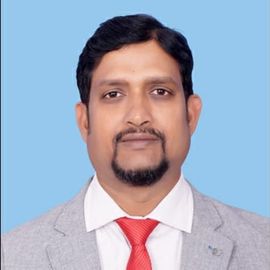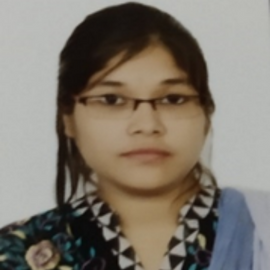Agenda
Conference Schedule
Day 1 full schedule
March 24, 2022 @ 09:30 - 13:50

Sanjay Kumar Gupta
Senior ScientistICAR-IIAB, Ranchi
India
ABSTRACT
To be updated soon

Himanshu S. Swain
ScientistICAR-Central Inland Fisheries Research Institute
India
ABSTRACT
To be updated soon

Deepika Korram
StudentCollege of Fisheries
India
ABSTRACT
Plankton (phyto and zooplankton) are microscopic organisms found in water, which are non-motile and cannot swim against the water currents. The biodiversity of plankton denotes the health indices and it is a very important factor determining the productivity of an aquatic ecosystem. Their distribution varies with the availability of light and nutrient. The aquatic organisms including fishes depend on plankton for their growth and development and thus comprise as an important component of the food web. North -Bihar is known for its wetlands (mauns and chaurs) and a network of important rivers viz. Ganga, Burhi Gandak, Gandak, Koshi, Bagmati etc. The zooplanktons found in river Burhi Gandak was dominated by Rotifera, Cladocera, Copepoda and Ostracoda group, and among phytoplankton Spirogyra sp., Scendesmus sp., Spirulina sp., Microcystis sp., were found to be dominated. In Balua chaur zooplanktons dominated by Copepoda, Cladocera, Brachionus sp. and Spirogyra sp.. Among phytoplankton Ulothrix sp., and Microspora sp. were dominant . Due to increasing human activities in terms of socio-economic development, discharge of waste, exploitation of fishery resources, reclamation of land, accelerated the loss of plankton biodiversity in rivers as well as wetlands of North-Bihar over the last few decades. The measurement of planktons productivity can helps in proper management of these water bodies and productivity of fishes.

Aditi Rambhau Banasure
Master’s StudentRatnagiri (Dr. Balasaheb Sawant Konkan Krishi Vidyapeeth, Dapoli)
India
ABSTRACT
As the population increases, country will require growth of Aquaculture for human consumption such as fish production industries. To prevent the environment and natural resources the sustainable aquaculture system is needed to develop. The environment friendly aquaculture system called “Biofloc technology” is considered as a “Blue revolution” in India. The main aim of the biofloc technology is to produce more aquaculture production without use of natural resources of water & land and increasing culture feasibility by reducing feed conversion ratio and a decrease of feed cost. Biofloc technology has already been introduced in India, China, Belgium, Israel, Switzerland, Iran and many more countries for O. niloticus,
C. carpio, L. vannamei, L. rohita, L. catla, C. mrigala etc. The higher growth with maintaining water quality and high density of such fish proved in Indian waters. Nearly one-sixth of India is defined as a Drought Prone Area, and as such recurring drought is one of the major challenges. In India there are many places which faces the water scarcity severally . Hence biofloc technology is very crucial in India as it is possible to use this technology to produce quality food with very limited utilization of water. The biofloc technology is efficient to culture IMC in polyculture mode and so, can be directly applied in scaled-up culture modules. This technology is not so popular for only nursery level culture as well as for ornamental fishes. This technology can be primarily used to produce the zooplankton as live food for young ones of the commercial food fishas well as ornamental fish. This technology is highly recommended and promoted by various researchers in India to insure the sustainable aquaculture and food security.
Nutritional Quality of the Fillet of Three Major Frozen Gadiform Fishes (Panla) Sold in Nigerian Markets

Adunola Bello
ResearcherFederal Institute of Industrial Research
Nigeria
ABSTRACT
Fish serves as an important food especially in developing countries and has gained attention due to its high protein content and nutritional value of unsaturated fatty acids. It currently has a great market potential when compared with beef, poultry, pork and egg. Gadiformes are major and widely acceptable frozen fishes sold in Nigerian market due to the believe that they possess low fat. The three major species of Gadiformes found in Nigerian markets are Merluccius merluccius, Gadus chalcogrammus and Micromesistius poutassou. This work focus on evaluating and comparing the nutritional qualities of the fillet of these three major frozen Gadiform fishes sold in Nigeria markets. The proximate composition of the fillets were determined according to AOAC methods while the mineral content were determined using Atomic Absorption Spectrophotometer. The fatty acid compositions of the oil extracted from the fillets were determined using GC-MS. The proximate composition showed that the fillet of Micromesistius poutassou had the highest protein and lowest fat content. Both Merluccius merluccius and Gadus chalcogrammus fillets were high in polyunsaturated fatty acids. The findings made in this study revealed Merluccius merluccius and Gadus chalcogrammus fillets have similar nutritional qualities. However all the three Gadiform fillets are of great nutritional importance.

Adunola Bello
ResearcherFederal Institute of Industrial Research
Nigeria
ABSTRACT
Mucuna is a legume with a low human preference for food, but has a high potential as an energy and protein source in livestock feed but is limited by the presence of anti-nutritional factor. Mucuna bean has not been put into much nutritional use mainly due to the high DOPA content and as a result, large quantities are going into waste. However, it has been reported that processing methods reduce the anti-nutritional factors of mucuna bean. The aim of this study is to determine the chemical composition of the oil extracted from two species of mucuna bean (Mucana pruriens and Mucuna utilis). The chemical properties of the oils of the two mucuna species investigated were determined using AOAC methods. The fatty acid compositions were determined using GC-MS. The chemical properties and fatty acids composition showed that the extracted oils are highly unsaturated and are easily susceptible to oxidation. This study shows that mucuna bean is a good source of polyunsaturated fatty acids and compares well with oils rich in polyunsaturated fatty acids such as soy bean and sunflower. If well processed to reduce the anti-nutrient, mucuna bean could be a good source of food for man and inclusion in livestock feed.

Kh. Victoria Chanu
Senior ScientistICAR-Central Inland Fisheries Research Institute
India
ABSTRACT
Recently epigenetics has attracted considerable attention and represents great opportunities in the aquaculture sector. Epigenetic trait refers to the stable heritable phenotype resulting from changes in the chromosome without any changes in the underlying DNA sequence. Epigenetic regulation is mainly mediated through histone modifications, DNA methylation and non-coding RNAs, e.g. miRNA. Epigenetic mechanisms provide possibility to integrate the genomic and environmental information to produce a desired phenotype. It is important to consider the potential role of epigenetics, since aquaculture operations mainly performed in open or natural conditions that are subject to changes in the environment. Evidence of epigenetic mechanisms is associated with commercially important traits in aquaculture were observed in few species like salmonids, rainbow trout, seabass, half-smooth tongue sole, oysters, mussels and brine shrimp. The key propose are where epigenetics can be applied in aquaculture, (i) environmental manipulation in the early life of the species such as fry or in the broodstock to induce an epigenetic memory either within or between generations to produce a desired phenotype (ii) epigenetic selection, which alone or combined with genetic selection may increase the reliability of producing animals with desired phenotypes. While many environmentally-induced epigenetic changes are transient, but environmental influenced epigenetic changes and phenotype can be passed on to the next generations/offspring. This creates a huge possibility of epigenetic programming in animal husbandry/aquaculture sector for selection of the most favourable phenotypic traits for production enhancement. Though epigenetics has huge potential, however epigenetic studies in economically important aquaculture species are still in its infancy and there are many unanswered questions. Through understanding of epigenetic mechanisms and epigenetic markers in aquaculture species will contribute to the selection of most favourable phenotypic traits for commercial aquaculture industry.
Study of Physico-chemical factor and seasonal variation of Phytoplankton in Fish pond, Machhali Ghar, Doranda, Ranchi, Jharkhand

Akriti Gupta
Ph.D. Research scholarRanchi University
India
ABSTRACT
Phytoplankton forms the necessary component of aquatic ecosystem, and plays a vital role as natural feed for the early life stages of various fish species. Occurrence of phytoplankton communities in the water body depends on the various properties of water quality. Hence, it absolutely necessary to understand the prevailing physico-chemical variations of water such as temperature, pH, total hardness, and electrical conductivity, total dissolved solids, turbidity, and dissolved oxygen etc. In this context, the present study was performed from July,2020 to June,2021 at some selected sampling stations ie, Nursury pond, Rearing pond and Stocking pond of the fish pond, Machli Ghar, Doranda, Ranchi. Four main groups of phytoplankton were identified in three sampling station, during the investigation period. A total of 45 species were observed, out of which 22 species from class Chlorophyceae, 10 species from class Cyanophyceae, 11 species from class Bacillariophyceae and 2 species from class Euglenophyceae were identified. Abundance of Chlorophyceae in the ponds indicates appropriate oxygen level in the water body. The monthly variation of water quality parameters revealed favorable range for the growth of phytoplankton.

Amrita Mohanty
PhD research scholarICAR-CIFE
India
ABSTRACT
Therapeutics based on messenger RNA (mRNA) have played a critical role in the pharmaceutical sector and have embarked in a huge change. So instead of synthesizing and isolating recombinant proteins with the appropriate post-translational modifications and folding in bacteria or other host systems, these treatments allow patients to produce therapeutic proteins in vivo. Since recently, wide variety of mRNA-based therapies have emerged. Because they are produced by in vitro transcription, modern therapies have facilitated the production of mRNA in cost-effective methods, can be produced rapidly, and have more flexibility. Unlike proteins, the procedures used here are unaltered by mRNA sequences. Aside from mRNA vaccinations, people have benefited from personalized medication based on their genomes. In addition to these benefits, there seems to be a number of challenges to overcome, including instability, immunogenicity, translation efficiency, and effective delivery methods. Therefore, understanding the structural features of mRNA, as well as the methods used for modification is essential. It highlights the most recent developments in these fields, as well as the development of mRNA delivery methods, and also preclinical and clinical applications of this emerging new class of potent drugs.

Adunola Bello
ResearcherFederal Institute of Industrial Research
Nigeria
ABSTRACT
Legumes are good sources of cheap and widely available proteins for human consumption. Legumes are usually known with the presence of anti-nutrients which can be reduced with different processing methods such as boiling, roasting, fermenting and so on. African yam bean (Sphenostylis stenocarpa) is among the most common legumes found in tropical regions of the world. It is one of the lesser known legumes that are now coming into prominence in nutritional and agronomic research as an emerging food legume. This work is aimed at evaluating the effect of these processing methods on the chemical composition of African Yam bean oil. The chemical properties of the oils extracted from the raw and processed African yam bean were determined using AOAC methods while the fatty acid composition of the oils were determined using GC-MS. The boiling and roasting processing increased the acid, peroxide and iodine value of the oils. Also, decrease in polyunsaturated fatty acids was observed. The study is an indication that processing methods have significant effect on the quality of African yam bean oil.

Bhaskar Gaikwad
ScientistNational Institute of Abiotics Stress Management
India
ABSTRACT
Fisheries cage culture has boomed in India in the past decade and is becoming a significant source of cultured inland fish for human consumption. The absence of a unified database of cage culture installation sites in India has created a hazy picture of cage culture growth for state and national agencies concerned with monitoring and formulation of policies for aquaculture. Generating the database of cage culture in inland open water bodies of India would be unfeasible by visiting the sites due to the sheer size of its geographical spread and the growth rate of the sector. Therefore, the remote identification of the cage cultures across the large water bodies using the multispectral satellite imagery of Sentinel 2A was explored. The bands (B1 to B12) were examined for their ability to distinguish the cage from non-cage features using CART (CART) and Random Forest (RF) classification techniques in the Google Earth Engine (GEE) platform. The sentinel images for Maharashtra state (India) corresponding to the latest google earth imagery were subjected to the image processing pipeline for removing cloud cover; separating water from land; segregating water bodies larger than 1000 ha; generating training and validation datasets; fitting machine learning models and generating model performance metrics. The overall, producer and consumer accuracies obtained using CART model for the validation dataset were 0.92, 0.91, and 0.93, respectively; and 0.95, 0.96, and 0.93, respectively for RF model. RF model performed better than CART in overall, producer and consumer accuracies and therefore could be used to identify cage culture installations regularly to create the database useful by the monitoring agencies.



